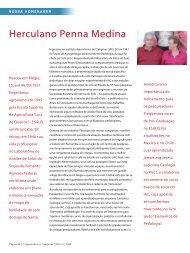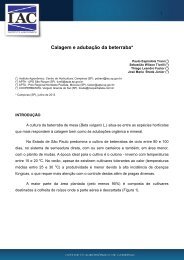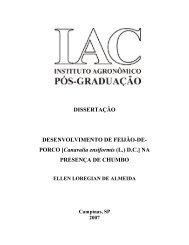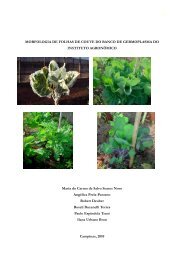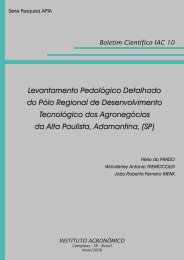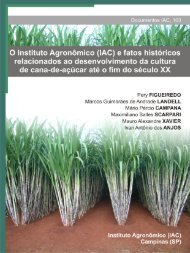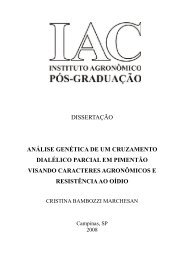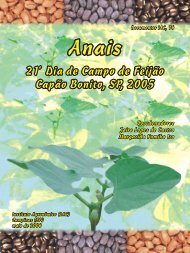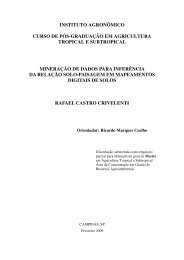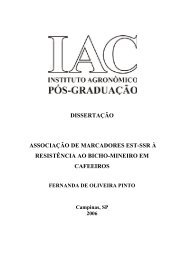Documentos IAC 84 - (ISSN 1809-7693) - Governo do Estado de ...
Documentos IAC 84 - (ISSN 1809-7693) - Governo do Estado de ...
Documentos IAC 84 - (ISSN 1809-7693) - Governo do Estado de ...
Create successful ePaper yourself
Turn your PDF publications into a flip-book with our unique Google optimized e-Paper software.
ABSTRACT<br />
COFFEE BREEDING OF COFFEA ARABICA L.:<br />
Transfer of resistance genetic factors to Hemileia vastatrix from Timor Hybrid<br />
to Villa Sarchí cultivar of Coffea arabica.<br />
Self progenies (F 2 ) from plants 1, 3 and 4 of the hybrid CIFC H 361 (Villa Sarchí x Híbri<strong>do</strong> <strong>de</strong><br />
Timor) and F 3 , F 4 and F 5 populations <strong>de</strong>rived from those plants during field trials conducted by <strong>IAC</strong> (C),<br />
IAPAR, IHCAFE (IHC), INMECAFE (IMC), UCM (CATIE-T), UCV and UFV were inoculated at CIFC green<br />
houses with all known 30 Hemileia vastatrix races. Analysis of the vertical rust resistance from populations<br />
allowed the classification of coffee-plants from the physiologic groups A, 1, 2, 3, R or 4, and E or β.<br />
Resistance of the first groups is evaluated by hypersensitivity reactions (R), mo<strong>de</strong>rate resistance (MR),<br />
mo<strong>de</strong>rate susceptibility (MS) and susceptibility (S) to the different races of H. vastatrix. Populations originated<br />
from the hybrid CIFC H 361 received the name Sarchimor in ana1ogy with the name Catimor given to<br />
populations originated from the hybrid CIFC 19/1 Caturra Vermelho x CIFC 832/1 Timor Hybrid (CIFC HW<br />
26). In field trials some populations originated from <strong>IAC</strong> 1668 (CIFC H 361/1) and <strong>IAC</strong> 1669 (CIFC H 361/<br />
4) from <strong>IAC</strong>, and IAPAR 74010 (CIFC H 361/1), IAPAR 75163 (originated from <strong>IAC</strong> 1669) from IAPAR <strong>de</strong>serve<br />
a specia1 reference. These populations exhibit a promising agronomic behaviour, similar to that of<br />
susceptible C. arabica varieties such as: Catuaí Vermelho and Catuaí Amarelo. Also, those populations<br />
originated the remarkable varieties Obatã <strong>IAC</strong> 1669-20 and Tupi <strong>IAC</strong> 1669-33 and the IAPAR 59, all with<br />
rust resistance. Other cultivars <strong>de</strong>rived from Sarchimor were also <strong>de</strong>veloped by several research institutions.<br />
F 3 or F 4 populations originated from UFV 349 (CIFC H 361/1), UFV 350 (CIFC H 361/4) and UFV 351<br />
(CIFC H 361/3) from UFV/EPAMIG and T 5296 (CIFC H 361/4) programme from PROMECAFE/CATIE also<br />
exhibit promising progenies at advance stage of agronomic selection. Hybrids (F 1 ) <strong>de</strong>rived from CIFC H<br />
361/4 (T 5296, Tupi <strong>IAC</strong> 1669-33, Obatã <strong>IAC</strong> 1669-20) with C. arabica progenies and cultivars Icatu<br />
Vermelho <strong>IAC</strong> 4045 and Icatu Vermelho <strong>IAC</strong> 4043 exhibiting high heterosis, were also obtained.<br />
Key words: Sarchimor; Coffea arabica; Villa Sarchí; Timor Hybrid; coffee rust; Hemileia vastatrix;<br />
physiologic groups and physiologic races.<br />
1. INTRODUÇÃO<br />
O trabalho apresenta<strong>do</strong> a seguir inci<strong>de</strong> sobre o híbri<strong>do</strong> CIFC H 361, sintetiza<strong>do</strong> no Centro <strong>de</strong><br />
Investigação das Ferrugens <strong>do</strong> Cafeeiro (CIFC), em 1967, entre o cafeeiro CIFC 971/10 da cultivar<br />
Villa Sarchí, suscetível à maioria das raças <strong>de</strong> ferrugem, incluin<strong>do</strong> a mais comum raça II (Grupo<br />
fisiológico E), e o cafeeiro CIFC 832/2 <strong>do</strong> Híbri<strong>do</strong> <strong>de</strong> Timor com resistência a todas as raças conhecidas<br />
<strong>do</strong> fungo (Grupo fisiológico A).<br />
Progênies F 2 <strong>de</strong> três plantas com os números 1, 3 e 4, selecionadas na população F 1 <strong>do</strong><br />
híbri<strong>do</strong> CIFC H361, foram enviadas em 1971 para instituições angolanas, IIAA e ICA, e brasileiras,<br />
UFV, EPAMIG, IBC e <strong>IAC</strong>, a fim <strong>de</strong> serem avaliadas em ensaios <strong>de</strong> adaptação e produtivida<strong>de</strong> nos<br />
respectivos Centros Experimentais.<br />
Posteriormente, sementes das gerações F 2 e F 3 <strong>do</strong> híbri<strong>do</strong>, obtidas <strong>de</strong> cafeeiros das estufas<br />
<strong>do</strong> CIFC e <strong>do</strong>s Centros Experimentais angolanos e brasileiros, <strong>de</strong>ram origem a plantas que foram<br />
incluídas em ensaios <strong>de</strong> campo nos Centros Experimentais <strong>de</strong> vários países (Colômbia, Costa Rica,<br />
El Salva<strong>do</strong>r, Guatemala, Honduras, México, Nicarágua, Panamá, República Dominicana, Laos, Malawi,<br />
Moçambique, São Tomé, Tailândia e Venezuela).<br />
A análise da resistência vertical às raças <strong>de</strong> H. vastatrix <strong>do</strong>s cafeeiros <strong>de</strong>riva<strong>do</strong>s <strong>do</strong> híbri<strong>do</strong><br />
CIFC H 361, efetuada no CIFC, incluiu três progênies F 2 formadas <strong>de</strong> sementes <strong>de</strong> plantas cultivadas<br />
em Oeiras e progênies F 3 , F 4 e F 5 obtidas <strong>de</strong> sementes <strong>de</strong> cafeeiros seleciona<strong>do</strong>s em ensaios <strong>de</strong><br />
campo <strong>de</strong> vários Centros Experimentais, <strong>de</strong> um comportamento promissor para as principais<br />
2<br />
<strong>Documentos</strong>, <strong>IAC</strong>, Campinas, <strong>84</strong>, 2008



